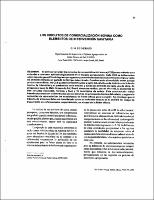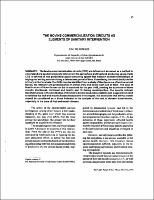Los circuitos de comercialización bovina como elementos de intervención sanitaria
The bovine commercialization circuits as elements of sanitary intervention
| dc.contributor.author | Moraes, G. M. | |
| dc.date.accessioned | 2019 | |
| dc.date.available | 2019 | |
| dc.date.issued | 1993 | |
| dc.identifier.citation | Moraes GM. Los circuitos de comercialización bovina como elementos de intervención sanitaria. Bol Cent Panam Fiebre Aftosa. 1993; 59: 29-36 | es_ES |
| dc.identifier.citation | Moraes GM. The bovine commercialization circuits as elements of sanitary intervention. Bol Cent Panam Fiebre Aftosa. 1993; 59: 37-44 | en_US |
| dc.identifier.issn | 0009-0131 | |
| dc.identifier.uri | https://iris.paho.org/handle/10665.2/51203 | |
| dc.description.abstract | Se definen y evalúan los circuitos de comercialización bovina (CCB) como método para entender e intervir epidemiológicamente en el espacio agropecuario. Cada CCB se define como aquel espacio geopolítico integrado por agentes que mantienen entre sí relaciones de compra y venta de animales durante un período de tiempo determinado. Considerando el municipio como unidad primaria de análisis, los CCB pueden ser identificados a partir del estudio de la dinámica del tránsito bovino, la intensidad y el predominio de la entrada y salida de animales en cada uno de ellos. Se presenta el caso de Mato Grosso do Sul, Brasil, donde se verifica, para el año 1989, la existencia de tres circuitos (Noroeste, Noreste y Sur) y 19 municipios de enlace. Esta constatación indica transformaciones en la distribución de los sistemas de producción bovina del estado y sugiere la necesidad de recaracterizar los ecosistemas de fiebre aftosa para la región. Se concluye que el tránsito de animales debe ser considerado como un indicador directo en el análisis del riesgo de transmisión de enfermedades, especialmente, en el caso de la fiebre aftosa. | es_ES |
| dc.description.abstract | The bovine commercialization circuits (CCB) are defined and assessed as a method to understand and epidemiologically intervene in the agricultural and livestock-producing space. Each CCB is defined as that geopolitical space containing agents that maintain mutual relationships of buying and selling animals during a determined period of time. Considering the municipality as the primary unit of analysis, the CCBs may be identified from a study of the dynamics of bovine animal transit, the intensity and predominance of animal entry and exit in each one of them. The case of Brazil's state of Mato Grosso do Sul is examined for the year 1989, yielding the existence of three circuits (Northwest, Northeast and South) and 19 linking municipalities. The results indicate transformations in the distribution of the state's bovine production systems and suggests the need to redefine the foot-amd-mouth disease ecosystems in the region. It is conclued that animal transit should be considered as a direct indicator in the analysis of the risk of disease transmission, especially in the case of foot-and-mouth disease. | en_US |
| dc.language.iso | es | es_ES |
| dc.language.iso | en | en_US |
| dc.publisher | OPS | es_ES |
| dc.relation.ispartofseries | Bol Cent Panam Fiebre Aftosa | |
| dc.subject | Fiebre Aftosa | es_ES |
| dc.subject | Bovinos | es_ES |
| dc.subject | Vigilancia Sanitaria | es_ES |
| dc.subject | Comercio | es_ES |
| dc.subject | Foot-and-Mouth Disease | en_US |
| dc.subject | Cattle | en_US |
| dc.subject | Health Surveillance | en_US |
| dc.title | Los circuitos de comercialización bovina como elementos de intervención sanitaria | es_ES |
| dc.title | The bovine commercialization circuits as elements of sanitary intervention | en_US |
| dc.type | Journal articles | en_US |
| dc.rights.holder | Pan American Health Organization | en_US |
| dc.contributor.corporatename | Organización Panamericana de la Salud | es_ES |
| paho.isfeatured | 0 | en_US |
| paho.publisher.country | Brazil | en_US |
| paho.publisher.city | Rio de Janeiro | en_US |
| paho.source.centercode | BR680.1 | en_US |
| paho.contributor.department | Centro Panamericano de Fiebre Aftosa y Salud Pública Veterinaria (PANAFTOSA) | |
| paho.journal.vol | 59 |





